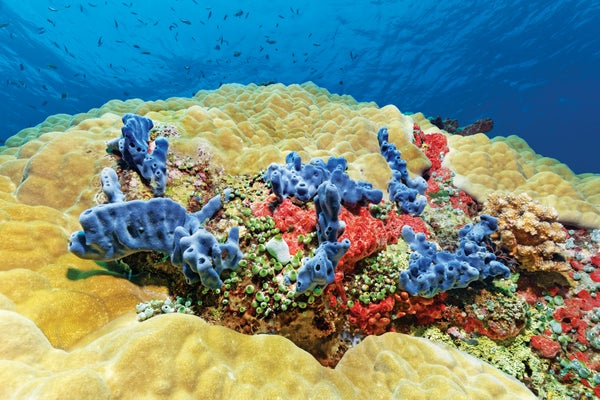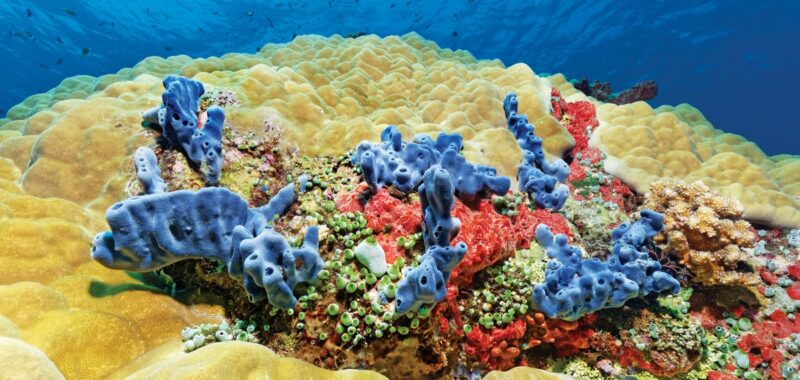February 11, 2025
4 min read
How Corals Fight Back against Warming Seas
Most corals can’t relocate, but they’re finding ways to beat the heat

Many corals have creative ways to fight the dangers of warming seas.
imageBROKER.com GmbH & Co. KG/Alamy Stock Photo
Deep underneath the eastern tropical Pacific Ocean lies a dazzling landscape of undulating coral reefs colored by photosynthetic algae, from which corals get their energy. But in the early 1980s an aquatic heat wave caused by the El Niño climate phenomenon led to a record-breaking mass-bleaching event, turning more than 90 percent of these corals a pale, lifeless white. The algae—which had thrived inside their coral hosts for millions of years—could no longer bear to live within them.
Strong El Niño events warmed up the same Pacific waters in the late 1990s and again in 2015–2016, but scientists noticed that these heat waves didn’t affect the reefs as badly as the first. Diving after the latest event, University of Miami marine biologist Ana Palacio saw that some of the corals seemed to be resisting or recovering from the bleaching. Maybe, Palacio thought, they’ve found a way to adapt.
Many adult corals are tethered to the reefs they build. Swimming to cooler waters is not an option, making them particularly vulnerable to the changing climate. But corals are also resilient, and scientists are discovering how they adapt. Some corals switch out their algal tenants for more heat-resistant species. Others can use rows of tiny hairs on their bodies to “fan” away excess harmful oxygen released by stressed-out algae. And certain baby corals modify their own metabolisms to withstand the warming waters. Scientists hope to use such natural adaptations in the race to preserve these crucial ecosystem anchors.
On supporting science journalism
If you’re enjoying this article, consider supporting our award-winning journalism by subscribing. By purchasing a subscription you are helping to ensure the future of impactful stories about the discoveries and ideas shaping our world today.
When Palacio and her team examined coral reefs after the 2015–2016 heat wave, they found that particular corals called Pocillopora—the main reef-building coral species in the eastern tropical Pacific—seemed to have expelled the algae that usually reside within them and taken in other species that were more tolerant to the heat.
“They start changing their [algae] community as the water becomes warmer and warmer, and they associate more and more with this thermotolerant algal symbiont called Durusdinium glynnii,” Palacio explains. This species’ name comes from the Latin word durus, meaning “rough” or “tough.” Most symbiotic algae produce toxic levels of oxygen under heat stress, forcing the corals to evict them. But Durusdinium keeps its levels tolerable.
Yet the corals don’t always rely on their algal guests to avoid excessive oxygen, researchers have found; sometimes they can take matters into their own “hands.” Rows of cilia—tiny, hairlike projections—can act like corals’ own personal ventilation system by fanning excess oxygen toward spots that lack it.
In 2022 marine biologists Cesar O. Pacherres and Soeren Ahmerkamp, then at the University of Bremen in Germany, showed that these fast-beating cilia create microscopic whirlpools in the water, swirling the oxygen around and preventing it from harmfully accumulating in any one spot. All corals have this ventilation system, but how much they use it can vary between species. The scientists now plan to test if and how some vulnerable corals—such as those in the Great Barrier Reef—beat their cilia faster in response to higher temperatures.
And corals aren’t always stuck in place; their larvae float freely through the ocean before settling, which offers crucial opportunities for a species to shift to more hospitable waters or spread its heat-tolerant genes. That’s why Ariana Huffmyer, a marine biologist at the University of Washington, is particularly interested in how baby corals adapt to higher temperatures. She and researchers at the Hawai’i Institute of Marine Biology recently showed that coral larvae, if exposed to warm water for as little as three days in the laboratory, alter their own metabolism to cope with heat stress and avoid bleaching.
Corals typically provide a small amount of nitrogen to their resident algae, and in return they get carbon, which they use as an energy source. “To maintain [the algae’s] own survival and give the nutrients required to the host, there’s a really intricate, delicate and very complex nutritional relationship between the two,” Huffmyer says. Under stress, corals produce too much nitrogen. This excess causes the algae to go into hyperdrive and divide a lot more—hoarding the carbon and keeping it from their hosts. Huffmyer discovered that baby corals exposed to short periods of heat stress learn to keep the excess nitrogen to themselves and don’t overshare with the algae, maintaining a stable symbiosis.
Pacherres cautions that such adaptations can protect an organism only to some extent. “They have the tools to withstand certain things, but past that limit there’s not enough they can do. For example, if it’s hot, we [humans] can sweat to alleviate the heat. But if it gets too hot, we die,” he says. “At one point sweating is not enough.”
But whatever heat-beating tools corals do have can help scientists develop protection strategies. Baby corals that can withstand stress are especially important for conservation efforts because they can travel between reefs and potentially share heat-tolerant genes in new locales. “The larvae from those reefs are already preadapted to some degree to rising temperatures, so we need to protect them because they’re in some ways the source of the future,” says Madhavi Colton, a conservation scientist who researched science-based tactics to save corals at the nonprofit Coral Reef Alliance.
Natural coral adaptations can also aid direct interventions like stress-hardening corals in nurseries before planting them back into ocean reefs. “You need to grow corals that are more likely to survive than the corals that died before,” Palacio says. If researchers can persuade corals to adopt heat-resistant algae or if they activate genes that can deal with heat stress, it raises the corals’ chance of surviving future ocean heat waves.
“When you dive and see a beautiful healthy reef with these colorful corals … I still feel this euphoria of being in this whole alien underwater world,” Huffmyer says. “It’s hard to go back after a bleaching event and see it dead. But that does give you the motivation to want to use whatever your skill set is, whatever your passion is, to try to help.”

